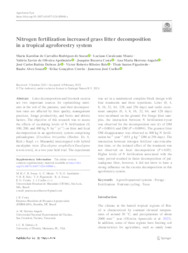Nitrogen fertilization increased grass litter decomposition in a tropical agroforestry system.
Nitrogen fertilization increased grass litter decomposition in a tropical agroforestry system.
Autoria: SOUSA, M. K. de C. R. de; MUNIZ, L. C.; APOLINÁRIO, V. X. de O.; COSTA, J. B.; HERRERA-ÂNGULO, A. M.; DUBEUX JÚNIOR, J. C. B.; REIS, V. R. R.; FIGUEIREDO, T. S.; SOUZA, R. A.; CORRÊA, E. G.; COELHO, J. J.
Resumo: Litter decomposition and livestock excreta are two important sources for replenishing nutrients in the soil of the pastures, and their decomposition rates are afected by their quality, management practices, forage productivity, and biotic and abiotic factors. The objective of this research was to assess the efects of escalating levels of N fertilization (0, 100, 200, and 400 kg N ha?1 yr?1) on litter and fecal decomposition in an agroforestry system comprising palisadegrass [Urochloa brizantha (Hochst. Ex A.Rich.) Stapf. cv. Marandu] intercropped with hybrid eucalyptus trees [Eucalyptus urophylla×Eucalyptus tereticornis], in a two-year feld trial. The experiment was set in a randomized complete block design with four treatments and three repetitions. Litter (0, 4, 8, 16, 32, 64, 128, and 256 days) and cattle excrement samples (0, 4, 8, 16, 32, 64, and 128 days) were incubated on the ground. For forage litter samples, the interaction between N fertilization×year was observed for the decomposition rate (k) of DM (P=0.0014) and OM (P=0.0094). The greatest litter OM disappearance was observed at 400 kg N fertilization ha?1 year?1 (651 g kg?1 DM at 256 days). The interaction between nitrogen fertilizer rate×incubation time, or the isolated efect of the treatment was not observed on fecal decomposition (P>0.05). Higher levels of N fertilization associated with the rainy period resulted in faster decomposition of palisadegrass litter, however, it did not show to have a strong infuence on the excreta decomposition in this agroforestry system.
Ano de publicação: 2024
Tipo de publicação: Artigo de periódico
Unidade: Embrapa Cocais
Palavras-chave: Adubação, Agrosilvopastoral systems, Decomposição fecal, Eucalyptus, Fertilization, Forage, Nutrient cycling, Trees
Observações
1 - Por padrão são exibidas publicações dos últimos 20 anos. Para encontrar publicações mais antigas, configure o filtro ano de publicação, colocando o ano a partir do qual você deseja encontrar publicações. O filtro está na coluna da esquerda na busca acima.
2 - Para ler algumas publicações da Embrapa (apenas as que estão em formato ePub), é necessário ter, no celular ou computador, um desses softwares gratuitos. Sistemas Android: Google Play Livros; IOS: iBooks; Windows e Linux: software Calibre.
Acesse outras publicações
Acesse a Base de Dados da Pesquisa Agropecuária (BDPA) para consultar o acervo completo das bibliotecas da Embrapa.

